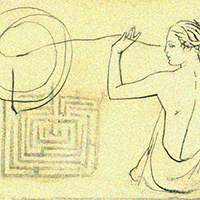The Arianna thread: the matching of S-100 family with the RyR’s muscle receptor

Accepted: 31 January 2020
HTML: 13
All claims expressed in this article are solely those of the authors and do not necessarily represent those of their affiliated organizations, or those of the publisher, the editors and the reviewers. Any product that may be evaluated in this article or claim that may be made by its manufacturer is not guaranteed or endorsed by the publisher.
The functional state of RyR depends on the intracellular calcium concentration and on the oxidation state of its protein components in some particular sites and of some sentinel amino acids. In addition to the regulation of the RyR channel by exogenous substances (caffeine, ryanodine), ions environmental situations (oxidative state), other components, such as some endogenous proteins present in the sarcoplasm and/or in muscle membranes that are able to determine changes in Ca2+ channel activity. Among these, calmodulin and S-100A could determine modifications in the status of RyR channel in the skeletal muscle. The currently available data can be justified the use of a simplified S-100/CaM and RyR interaction model for the regulation of Ca2+ release in skeletal muscle. Under resting conditions, the CaM/S100A1 binding domain on RyR1 is predominantly dependent on S100A1. Vice versa when the intracellular Ca2+ concentration becomes high as well as during repetitive (tetanus) stimulation, the Ca-CaM bond becomes dominant, shifting S100A1 from RyR1 and promoting channel inactivation. This may be one of the mechanism of muscle fatigue.
Franzini-Armstrong C, and Protasi F. Ryanodine receptors of striated muscles: A complex channel capable of multiple interactions. Physiol Rev 1997;77:699–729. doi: 10.1152/physrev.1997.77.3.699. DOI: https://doi.org/10.1152/physrev.1997.77.3.699
Fabiato A. Calcium-induced release of calcium from the cardiac sarcoplasmic reticulum. Am J Physiol 1983;245(1):C1–C14. doi: 10.1152/ajpcell.1983.245.1.C1. DOI: https://doi.org/10.1152/ajpcell.1983.245.1.C1
Sun QA, Wang B, Miyagi M, et al. Oxygen-coupled redox regulation of the skeletal muscle ryanodine receptor/Ca2+ release channel (RyR1): Sites and nature of oxidative modification. J Biol Chem 2013;288:22961–22971. doi: 10.1074/jbc.M113.480228. DOI: https://doi.org/10.1074/jbc.M113.480228
Meissner G. Ryanodine receptor/Ca2+ release channels and their regulation by endogenous effectors. Annu Rev Physiol 1994;56:485–508. doi: 10.1146/annurev.ph.56.030194.002413. DOI: https://doi.org/10.1146/annurev.ph.56.030194.002413
Ngo VA, Perissinotti LL, Miranda W, et al. Mapping ryanodine binding sites in the pore cavity of ryanodine receptors. Biophys J 2017;112:1645–1653. doi: 10.1016/j.bpj.2017.03.014. DOI: https://doi.org/10.1016/j.bpj.2017.03.014
Liu W, Meissner G. Structure-activity relationship of xanthines and skeletal muscle ryanodine receptor/Ca2+ channel release. Pharmacology 1997;54(3):35-43. doi: 10.1159/000139480. DOI: https://doi.org/10.1159/000139480
Fanò G, Biocca S, Fulle S, et al. The S-100: a protein family in search of a function. Prog Neurobiol 1995; 46(1):71-82). doi: 10.1016/0301-0082(94)00062-m. DOI: https://doi.org/10.1016/0301-0082(94)00062-M
Xu L, Meissner G. Mechanism of calmodulin inhibition of cardiac sarcoplasmic reticulum Ca2+ release channel (ryanodine receptor). Biophys J 2004;86:797–804. doi: 10.1016/S0006-3495(04)74155-7. DOI: https://doi.org/10.1016/S0006-3495(04)74155-7
Yamaguchi N, Chakraborty A, Huang TQ, et al. Cardiac hypertrophy associated with impaired regulation of cardiac ryanodine receptor by calmodulin and S100A1. Am J Physiol Heart Circ Physiol 2013;305:H86–H94. doi: 10.1152/ajpheart.00144.2013. DOI: https://doi.org/10.1152/ajpheart.00144.2013
Moore BW. A soluble protein characteristic of the nervous system. Biochem Biophys Res Commun 1965;19:739–744. doi: 10.1016/0006-291x(65)90320-7. DOI: https://doi.org/10.1016/0006-291X(65)90320-7
Baudier J, Gerard D. Ions binding to S100 proteins. Conformational studies and calcium-induced conformational changes in S100 alpha protein: the effect of acidic pH and calcium incubation on subunit exchange in S100a (alpha beta) protein. J Biol Chem 1986;261(18):8204-12. DOI: https://doi.org/10.1016/S0021-9258(19)83896-6
Volkers M, Rohde D, Goodman C, et al. S100: a regulator of striated muscle sarcoplasmic reticulum Ca2+ handling, sarcomeric and mitochondrial function. J Biomed Biotechnol 2010;2010:178614. doi: 10.1155/2010/178614. DOI: https://doi.org/10.1155/2010/178614
Ikura M. Calcium binding and conformational response in EFhand proteins. Trends Biochem Sci 1996;21:14–17. DOI: https://doi.org/10.1016/S0968-0004(06)80021-6
Adhikari BB, Wang K. S100A1 modulates skeletal muscle contraction by desensitizing calcium activation of isometric tension, stiffness and ATPase. FEBS Lett 2001; 497:95–98. doi: 10.1016/s0014-5793(01)02444-9. DOI: https://doi.org/10.1016/S0014-5793(01)02444-9
Riuzzi F, Sorci G, Arcuri C, Giambanco I, Bellezza I, Minelli A, Donato R. Cellular and molecular mechanisms of sarcopenia: the S100B perspective. J Cachexia Sarcopenia Muscle 2018;9(7):1255-1268. doi: 10.1002/jcsm.12363. DOI: https://doi.org/10.1002/jcsm.12363
Fanò G, Marsili V, Angelella P, et al. S-100a0 protein stimulates Ca2+-induced Ca2+ release from isolated sarcoplasmic reticulum vesicles. FEBS Lett 1989;255:381–384. doi: 10.1016/0014-5793(89)81127-5. DOI: https://doi.org/10.1016/0014-5793(89)81127-5
Fanò G., Marsili V, Protasi F, et al. BAM 1992;2(4):309-315.
Prosser BL, Hernandez-Ochoa EO, Schneider MF. S100A1 and calmodulin regulation of ryanodine receptor in striated muscle. Cell Calcium 2011;50(4):323–331. doi: 10.1016/j.ceca.2011.06.001. DOI: https://doi.org/10.1016/j.ceca.2011.06.001
Yamaguchi N, Prosser BL, Ghassemi F, et al. Modulation of sarcoplasmic reticulum Ca2+ release in skeletal muscle expressing ryanodine receptor impaired in regulation by calmodulin and S100A1. Am J Physiol Cell Physiol 2011;300:C998–C1012. doi: 10.1152/ajpcell.00370.2010. DOI: https://doi.org/10.1152/ajpcell.00370.2010
Marsili V, Mancinelli L, Menchetti G, Fulle S, Baldoni F, Fanò G. S-100ab increases Ca2+ release in purified sarcoplasmic reticulum vesicles of frog skeletal muscle. J Muscle Res Cell Motil 1992;13(5):511-515. doi: 10.1007/bf01737993. DOI: https://doi.org/10.1007/BF01737993
Bers D. Calmodulin and S100A1 fine tune skeletal muscle E-C coupling (editorial) Am J Physiol Cell Physiol 2011;300:C974–C975. DOI: https://doi.org/10.1152/ajpcell.00051.2011
Rebbeck RT, Nitu FR, Rohde P, et al. S100A1 protein does not compete with calmodulin for ryanodine receptor binding but structurally alters the ryanodine receptor-calmodulin complex. J Biol Chem 2016;291:15896-15907. doi: 10.1074/jbc.M115.713107. DOI: https://doi.org/10.1074/jbc.M115.713107
PAGEPress has chosen to apply the Creative Commons Attribution NonCommercial 4.0 International License (CC BY-NC 4.0) to all manuscripts to be published.


 https://doi.org/10.4081/ejtm.2019.8839
https://doi.org/10.4081/ejtm.2019.8839



